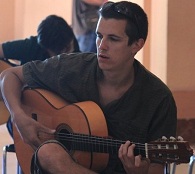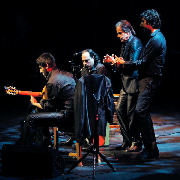Welcome to one of the most active flamenco sites on the Internet. Guests can read most posts but if you want to participate click here to register.
This site is dedicated to the memory of Paco de Lucía, Ron Mitchell, Guy Williams, Linda Elvira, Philip John Lee, Craig Eros, Ben Woods, David Serva and Tom Blackshear who went ahead of us.
We receive 12,200 visitors a month from 200 countries and 1.7 million page impressions a year. To advertise on this site please contact us.
|

|
|
Paco and compas.
|
You are logged in as Guest
|
|
Users viewing this topic: none
|
|
Login  | |
|

   
Ricardo
Posts: 14899
Joined: Dec. 14 2004
From: Washington DC

|
 RE: Paco and compas. (in reply to Stu) RE: Paco and compas. (in reply to Stu)
|
|
|
quote:
ORIGINAL: Stu
Thanks Ricardo, that's kind of what I thought, thanks for confirming that!
I'm still a little unsure on one thing though, although he's being liberal which doesn't make it rhythmically obvious, I would still have thought that I could tap a constant beat to it and although it may sound full of push and pull it is still happening withing that constant beat.
For example if we knew exactly what speed he was playing and ran a metronome behind it (at that speed) would he be getting ahead of it and falling behind it, but eventually catching up and be in time with it, or would he just lose that click altogether? hope that makes sense it does in my head.
Stu
I know some folks look at rubato like a give and take, and it all works out in the end. But I dont' hold to that. To me, the only way to hold tempo solid is to groove. Once you displace a single subdivided note, you imlpy a different tempo, and the groove is over. So basically NO, as soon as the tempo was changed, it changed for ever. Perhaps he revisits it, but metronome idea would never work unless you turned the dial accordingly. So pointless to tap steadily. You can however, follow the tempo changes just fine if you truely understand how he subdivides. That is how we actually change tempo with a dancer. A dancer can change tempo just with contra tiempos for example, without needing to mark the beat and accents.
_____________________________
CD's and transcriptions available here:
www.ricardomarlow.com
|
|
|
|
REPORT THIS POST AS INAPPROPRIATE |
Date Nov. 30 2008 9:53:33
 |
|

   
mark indigo
Posts: 3625
Joined: Dec. 5 2007

|
 RE: Paco and compas. (in reply to Ramirez) RE: Paco and compas. (in reply to Ramirez)
|
|
|
i learnt the alegrias "barrio la vina" off paco's "el duende flamenco" album a while ago and found same thing.... i had the decision of whether to play metronomically or "a compas elastico" (ie the compas and accents are the same but the tempo is speeding up and slowing down).
i found it much easier in this case to go with paco's stretching of compas etc. than to play metronomically, because that was how i had heard it and studied it from the cd, and metronomically it sounded "wrong" even though i also learnt to play it like that as well and found it a good practise thing to do (and BTW other alegrias i play strictly metronomically "a compas"). any time paco does a picado run in these pieces the tempo is way accelerated...
as ricardo said already, this "elastic compas" is found also in solea, and it's not just paco, many other guitarists play in this way in slower compas forms, such as solea (i'm thinking vicente amigo's "tio arango" which i find impossible to clap palmas to, even though i can sort of hear the accents/compas).
also in siguiriyas, i'm learning a siguiriyas at the moment, and on the cd it's really elastic and stretchy, even though i can hear the compas and accents etc. when i played a bit of it last week a dancer started to clap and then told me it was out of compas, even though i was exactly as the cd.... and in siguiriyas i think the stretchy thing is even more pronounced and common, 'cos it's sung in that elastic way. i'm sort of trying to learn it both ways at the moment, but leaning towards practising with the metronome.
|
|
|
|
REPORT THIS POST AS INAPPROPRIATE |
Date Dec. 1 2008 8:49:30
 |
|

   
mark indigo
Posts: 3625
Joined: Dec. 5 2007

|
 RE: Paco and compas. (in reply to Ricardo) RE: Paco and compas. (in reply to Ricardo)
|
|
|
quote:
General rule when learning or teaching, is metronome first (or foot palmas loop, etc ie steady tempo), elastic second. Once you learn the "elastic" version, it is really hard to "unlearn" it and do it with palmas or dance if you need to. It gets printed on your brain a certain way that is tough to erase. But if you learn it with proper rhythm, then later stretching it how you want, is easy.
i agree, that is my usual rule too, problem being when learning something from an elasticated recording! and i agree that it is hard to unlearn the elastication - i've done it!
in a way though, these type of alegrias (slow-ish, very elastic, with tremelo, modulating between major and minor etc) are probably not meant to be used in accompaniment, they are composed and performed as concert solos, loosely based on the compas and form of alegrias - just a thought.
quote:
General rule when learning or teaching, is metronome first
quote:
any time paco does a picado run in these pieces the tempo is way accelerated...
i definately stick to the general rule on these passages! 
|
|
|
|
REPORT THIS POST AS INAPPROPRIATE |
Date Dec. 2 2008 12:34:37
 |
|
 New Messages New Messages |
 No New Messages No New Messages |
 Hot Topic w/ New Messages Hot Topic w/ New Messages |
 Hot Topic w/o New Messages Hot Topic w/o New Messages |
 Locked w/ New Messages Locked w/ New Messages |
 Locked w/o New Messages Locked w/o New Messages |
|
 Post New Thread
Post New Thread
 Reply to Message
Reply to Message
 Post New Poll
Post New Poll
 Submit Vote
Submit Vote
 Delete My Own Post
Delete My Own Post
 Delete My Own Thread
Delete My Own Thread
 Rate Posts
Rate Posts
|
|
|
Forum Software powered by ASP Playground Advanced Edition 2.0.5
Copyright © 2000 - 2003 ASPPlayground.NET |
0.078125 secs.
|


 Printable Version
Printable Version







 I asked a professional player, and he said. Yes this media media compas is there, but the feeling in this falseta sounds natural.. so its allowed.
I asked a professional player, and he said. Yes this media media compas is there, but the feeling in this falseta sounds natural.. so its allowed. 

 .and sometimes i could swear shes shortening or making the values longher to match her pause for breath and instructions to dancers...etc..
.and sometimes i could swear shes shortening or making the values longher to match her pause for breath and instructions to dancers...etc.. 


 New Messages
New Messages No New Messages
No New Messages Hot Topic w/ New Messages
Hot Topic w/ New Messages Hot Topic w/o New Messages
Hot Topic w/o New Messages Locked w/ New Messages
Locked w/ New Messages Locked w/o New Messages
Locked w/o New Messages Post New Thread
Post New Thread